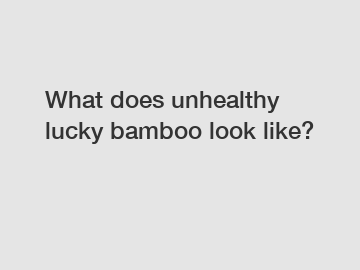What does unhealthy lucky bamboo look like?
What does unhealthy lucky bamboo look like?
Lucky bamboo, with its unique appearance and symbolism of good luck, has become a popular choice for indoor decoration. However, like any other plant, lucky bamboo requires proper care and attention to thrive. When it is not well cared for, this once vibrant green plant can start to show signs of decay and decline. So, what does unhealthy lucky bamboo look like?
Unhealthy lucky bamboo often displays visible symptoms that indicate its poor state of health. The most noticeable sign is yellowing leaves. Instead of its usual vibrant green color, the leaves may become pale or develop yellow spots. In severe cases, the leaves may even turn brown and wither. Additionally, unhealthy lucky bamboo can exhibit stunted or distorted growth. The shoots may become weak and thin, fail to grow taller, or produce small and underdeveloped leaves. These visible manifestations of distress are indicators of a plant suffering from various issues, such as inadequate light, incorrect watering, or nutrient deficiencies.

To understand why lucky bamboo becomes unhealthy, we need to examine the key factors that contribute to its well-being. Firstly, lucky bamboo is known for its low light requirements, but it still needs sufficient indirect light to perform photosynthesis effectively. Placing the plant in an area with insufficient light can lead to weakened growth and yellowing leaves. On the other hand, too much direct sunlight can scorch the leaves and cause them to turn brown. Therefore, finding the right balance of light exposure is crucial for maintaining the plant's health.
Secondly, improper watering practices can also harm lucky bamboo. Over-watering or allowing the plant to sit in standing water can lead to root rot, resulting in yellowing leaves and stunted growth. On the contrary, under-watering deprives the plant of the necessary moisture, leading to dry and withered leaves. Finding a watering routine that keeps the soil consistently moist but not waterlogged is essential for the plant's vitality.
Lastly, lucky bamboo's health depends on a well-balanced nutrient supply. Using plain tap water or water that contains high levels of chlorine and fluoride can damage the plant. It is crucial to use filtered water or let tap water sit for 24 hours to allow the chlorine to dissipate before watering. Additionally, lucky bamboo benefits from occasional fertilization with a balanced liquid houseplant fertilizer to provide essential nutrients.
Understanding the signs of unhealthy lucky bamboo is important because it allows us to take corrective measures promptly. By addressing the underlying causes of the plant's decline, we can restore its health and appearance. Regularly inspecting the leaves and shoots, adjusting light exposure, adopting proper watering techniques, and providing appropriate nutrients can all contribute to the well-being of lucky bamboo.
In conclusion, unhealthy lucky bamboo exhibits yellowing leaves and stunted growth as visible signs of distress. These symptoms are usually caused by inadequate light, improper watering, or nutrient deficiencies. By understanding the factors that contribute to the plant's well-being and taking appropriate actions, we can ensure the longevity and beauty of lucky bamboo in our indoor spaces. Remember, a healthy and thriving lucky bamboo brings not only aesthetic appeal but also good fortune and positive energy into our lives.
Are you interested in learning more about How to cook with fresh bamboo leaves?, Sushi Serving Bamboo Tubes, Dried Bamboo Leaves for Australia? Contact us today to secure an expert consultation!

Comments
0